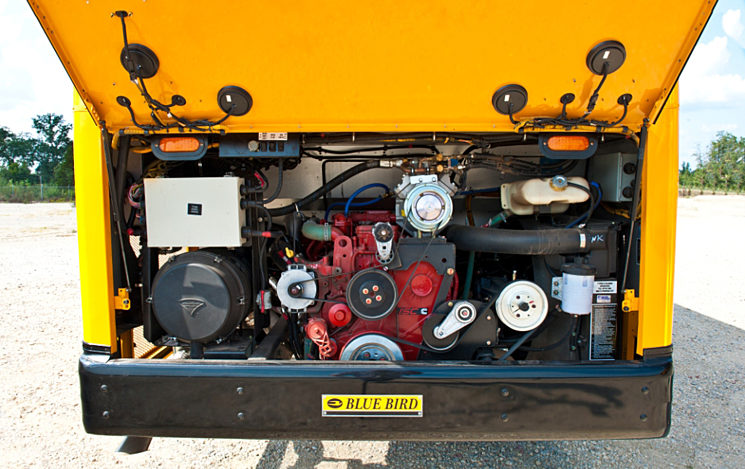Engines and Transmissions
I am not an engine expert so I can only relay to you what I have learned during my bus-hunting. The most reliable and powerful engines are the International DT466 and the Cummins 8.3 however these are generally found in the largest buses. The less powerful versions of these engines found in shorter buses are the International T444E and the Cummins 5.9. Also up for consideration is the Detroit Diesel 6V92 and 8V71. These extremely robust engines used for decades in greyhound coaches are old, dirty (in that they burn and leak oil by design), and are not terribly fuel efficient, but they are basic, powerful, and very hard to kill. You will also encounter the Caterpillar CAT 3116, the Mercedes Benz MBE906, and perhaps a few other obscure engines. The CAT and the Mercedes Benz engines are generally avoided by bus builders due to a significantly higher cost of repair and more known reliability issues. However if you don’t plan to drive your bus much, or at all, or you happen to be a whiz mechanic you may find the perfect platform for your Skoolie conversion with one of these engines. Don’t be afraid to go for it. After all the US armed services has used CAT engines for decades. As for gas engines, just stay away.
Each of these engines started out as all mechanical engines when originally built. Eventually computers were developed to tune them which in some cases made them more efficient and made them easier to diagnose by technicians, just like cars. If you plan to do your own work on your own bus however consider shopping for an all mechanical version of your engine, which will start to limit your bus search to the mid 1990’s and earlier depending on the engine. The addition of computers makes these engines more complicated to work on and requires more specialized tools. If you see an engine listed as the DT466″E”, you know it’s the “electric” version.
Finally around 2004 to 2007 the EPA started requiring diesel engine manufacturers to comply with new diesel exhaust requirements that made the engines less reliable, more complicated, and more expensive to work on. General consensus among Skoolie builders is to stay away from engines with DEF requirements, and limit your search to pre-DEF buses. However eventually as older buses become scarce we will learn to adapt to buses that require DEF fluid.
The preferred transmissions are made by Allison. Avoid all made by Voigt. Manual transmissions, while rare could be fun for some drivers, but not for most.
Most common among Allison transmissions are the MD 3060, the MT643, the Allison 2000 and the AT545. The first 3 are great transmissions and the last one has a few cons. Without going into great detail the AT545 when paired with a large and heavy bus will not perform well when driving up and down hills and has been known to damage powerful engines like the DT466 although they are not often paired together for this reason. If you plan to drive up and down mountains in your heavy and large school bus conversion consider avoiding the AT545. If this bus is your weekend camper or will not be driven often, or will not be driven up and down mountains, then this transmission will likely not be an issue for you.
It is not the transmission that limits the top speed of your school bus but the gear ratio. While gear ratios can generally be changed this may be an expensive endeavor. I think the best thing to do is to make sure the bus you buy does the speed you need. Almost all buses will not drive faster than 70MPH but in my opinion your bus should do at least around 65MPH to keep you happy (Gilligan Phantom tops out at 68MPH). Some drivers will be okay with 60MPH or a little bit lower, but some buses will actually be geared or governed to 45MPH which you definitely won’t be happy with. When bus shopping ask and confirm how fast your bus will go before buying.
There are a few more considerations just to complicate your bus shopping a little bit more: Some states require a special license to drive a bus with a GVW (Gross Vehicle Weight) over 26,000 Lb’s. Others require an “air brake endorsement” on your license. While getting licensed to drive these vehicles is well within your scope of capabilities if you are capable of converting and driving around in a skoolie it is an added complication. Also some buses will have large wheel-bases, long tails, or sharp approach or departure angles which will limit maneuverability. Some national parks limit the length of vehicles to 35 or 30 feet and some city roads just weren’t built for the biggest school buses. Be sure to patiently dial in your needs while bus shopping, and not after you’ve bought your bus. Figure out the smallest bus that you can comfortably live with given your family’s needs and then consider going a little smaller, not a little larger. Be patient in your search until you find the right one.
What about rust? Yes rust is a major issue when school bus shopping. The general consensus is that a little bit of rust is okay. If you see any rust on the bus you are buying expect to find more when you get to the demolition stage. However if you discover significant frame or body rust when inspecting I would advise you to take a pass on that bus. Significant rust will likely lead to major additional work on your part. You are better off traveling further if necessary for a rust free bus. The best states of course are the dry western states such as California, Arizona, Nevada etc. where you can find a practically rust free bus, like Gilligan. If you’re buying this bus for adventure, you might as well start with a big one getting it home if you don’t already live in the southwest!
You will encounter school buses with air brakes and hydraulic brakes. Neither are deal breakers but most consider air brakes to be better. You will also find leaf spring and air suspensions, with the air suspension providing a softer ride for you, your passengers, and your possessions.
Finally consider that anything you find essential to your Skoolie adventure could already be built into your bus if you choose the right one and could save you time, effort, and money. As you’ll see in the following chapters Skoolie converting is hard work, time consuming, and eventually you will likely find yourself burnt out. Anything that you can do to lighten the load in advance with your bus purchase you will thank yourself for later, so I will leave you with our bus shopping criteria that lead us to Gilligan:
Around 35 feet (oops, Gilligan is 40 feet), undercarriage storage (we have plenty), rear engine, tinted windows, DT466, Cummins 8.3 or Detroit Diesel 6V92 engines, no AT545 transmission, tall ceiling height (at least 75 inches, the taller the better, Gilligan was 77 inches), pre DEF, preferably all mechanical engine (Gilligan is all mechanical).
The last thing that you will want to look at is mileage. These diesel engines are built to last much longer than engines in cars. In transit and highway coach vehicles which used some of the same engines as school buses from the 1980’s to early 2000’s routinely do 500K+ miles before they are put out of service. It turns out service history and engine condition is much more important than mileage. We bought Gilligan with 200K on the clock and expect to be able to put many more miles on him.
Here is one last tip for your bus shopping before we move on to the next chapter: when searching for your bus it is often challenging to find the engine and transmission information in a listing, but the VIN is almost always included. Try using a VIN decoder such as: https://driving-tests.org/vin-decoder/ and https://vpic.nhtsa.dot.gov/decoder/Decoder which will sometimes help you identify the engine and transmission and will even sometimes give you some indication of the headroom, length, GVWR etc. Trying cross-referencing as many VIN decoders as you can find to confirm that you’re receiving correct information. s
Okay happy hunting. On to the demolition!





4 Comments
I love the build so far that I’m seeing and we are thinking of doing the same thing. the big question is how much did u purchase Gilligan for?
Hey Shawn. We bought Gilligan from a dealer for 7K. He had 200K on the clock and was in really great condition. He needed new tires though ($2,500-$3,500 for 6, but you can get tires a bit cheaper) so by the time we put those on two years later the initial purchase was more like 10K.
I’m just getting into the black hole of this endeavor and your site and youtube and insta are awesome and very helpful. I have a silly question though…… are buses male?? All my cars have been female, and it seems like the vast majority of people that name their cars consider them female.
Hmm maybe buses can be either.